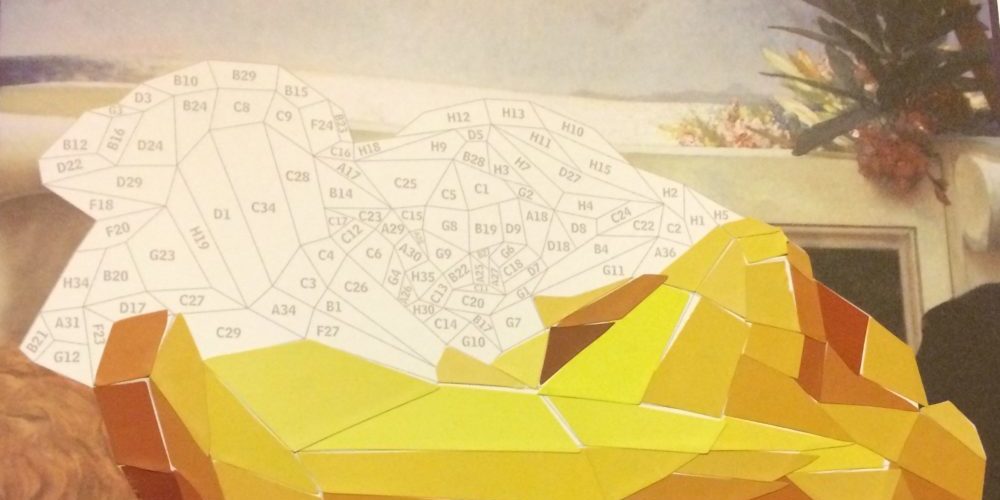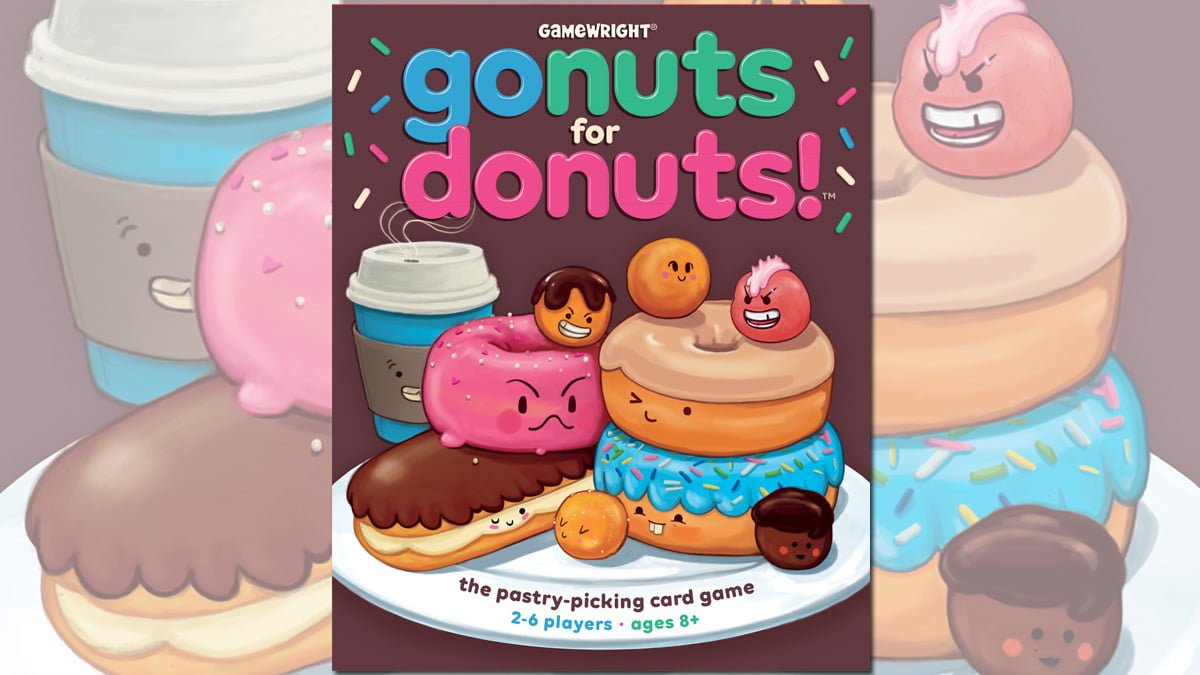
What is Go Nuts for Donuts?
Go Nuts for Donuts is a fun, family card game for two to six players. In the game, players collect different types of donuts in the hope of getting the most points when the Donut Deck runs out.
Components
- 70 Donut Cards
- 42 Selection cards
- 7 Donut Row Indicators
- Instruction Booklet
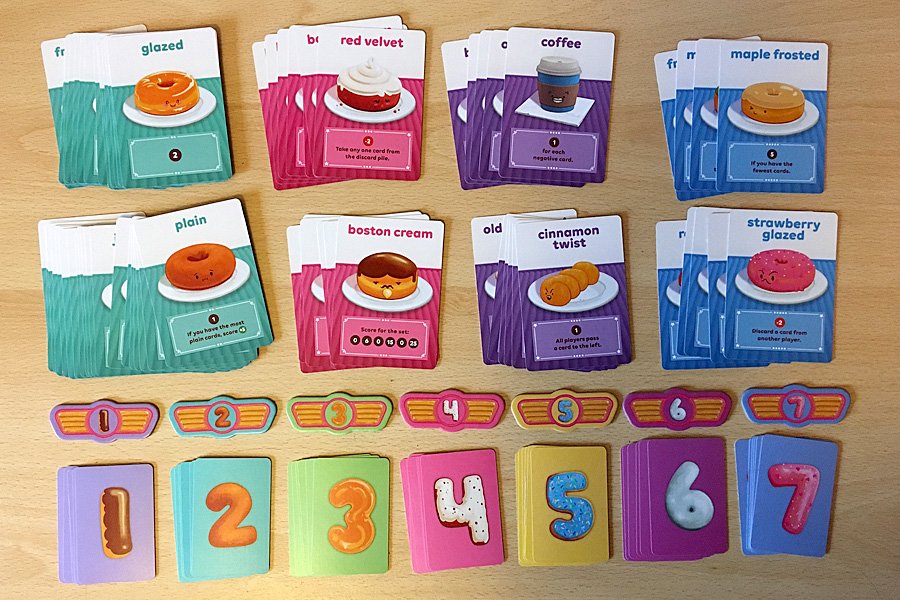
How Do You Play Go Nuts for Donuts?
Setup
To begin a game of Go Nuts for Donuts, each player is given a set of Selection cards. The number of cards received should be equal to the number of players plus one, so in a three-player game, each player receives cards one, two, three, and four. The same number of Donut Row indicators are placed in the play area with space to place a single card beneath each one.
The Donut Deck is then created (we’ll look at this in more detail later). As with the Selection Cards, the Donut Deck is also affected by the number of players. The cards used in the Donut Deck are as follows:
- Two-Players: Turquoise Cards Only
- Three-Players: Turquoise and Pink Cards
- Four-Players: Turquoise, Pink, and Purple Cards
- Five and Six Players: Turquoise, Pink, Purple, and Blue Cards
The correct cards are shuffled together and the Donut Deck is then placed face-down in the center of the play area. Cards are then drawn from the Donut Deck to place one under each Donut Row indicator. Once this is done, you are ready to play.
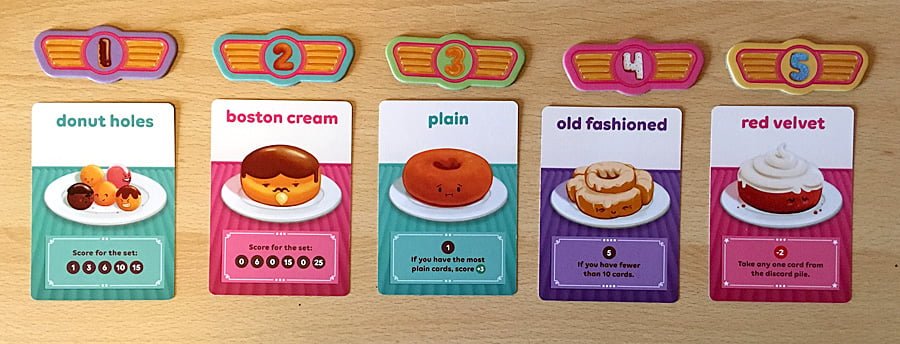
Gameplay
A game of Go Nuts for Donuts takes place over several rounds until the Donut Deck runs out and at least one space on Donut Row cannot be filled.
In a round, each player silently looks at the available cards on Donut Row and decides which one they would like to add to their hand. They then find their corresponding Selection Card and place it face-down in front of them. For example, if I wanted to pick card number two from the above picture, I would find my card two selection card, and place it face-down in front of me. Once every player has placed a Selection Card in front of them, they are all flipped over simultaneously.

If two or more players picked the same card, nobody gets it. That card is moved from Donut Row to the discard pile.
If you were the only player to pick a number, you get to take that card from Donut Row and add it to your hand. This happens in numerical order with the lowest numbered donuts taken first. Some cards affect others so this rule simplifies the order in which actions should be taken. All cards in your hand are kept face-up in front of you so other players can see them for the rest of the game.
Once all the selected cards have been taken from Donut Row and any actions have been taken (actions only take place when a Donut Card is removed from Donut Row, not if it is taken from another player, the discard pile, or drawn from the deck) a new round begins. Donut Row is refilled with cards from the Donut Deck, and players take back their Selection Cards to begin again. This continues until there are no longer enough cards in the Donut Deck to refill Donut Row which triggers the end of the game.
The Donut Deck
There are 23 different types of donuts (including a couple of drinks) in the deck and the number of each type varies. There is only one Milk card, and only one Day-Old Donuts card, but seven Plain Donuts are available.
Each card impacts the game in different ways, some more simple than others. A Powdered Donut simply gives you three points at the end of the game, while Donut Holes work as multipliers, giving you a single point if you only hold one Donut Holes card at the end, three points if you hold two, six points if you hold three and so on. The best strategies involve some level of planning to maximize certain collections and use actions to your advantage.
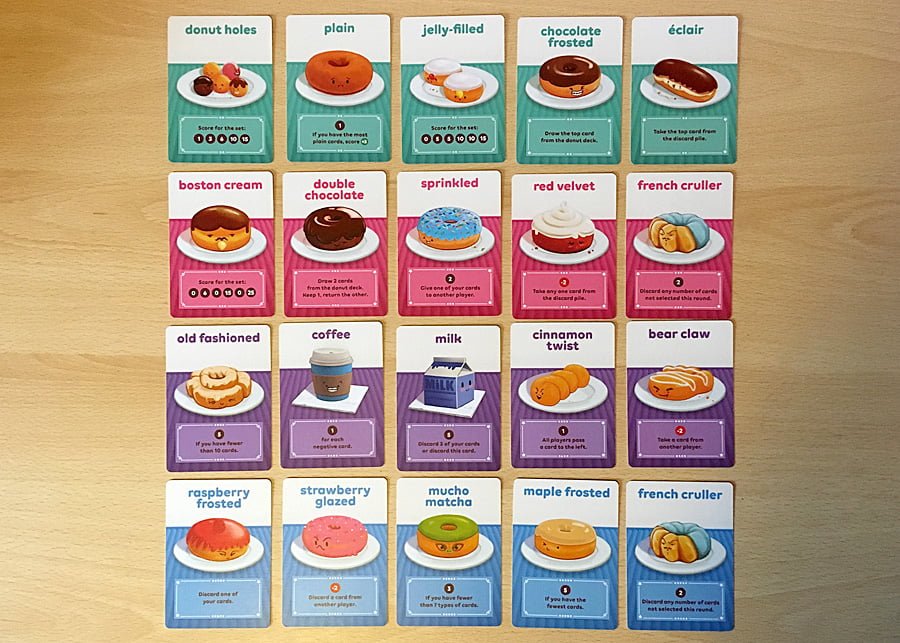
Here are some more of the different card types:
- Maple Bar: Score three points if you have more than six types of donuts in your hand at the end of the game
- Coffee: Score one point for each negative points card you have at the end of the game
- Day-Old Donuts: Score negative seven points at the end of the game but take up to three cards from the discard pile when you pick this up
- Sprinkled: Score two points at the end of the game, when you take this card from Donut Row you must give one of your cards to an opponent
Some of the cards may initially seem like bad choices to pick up, Day-Old Donuts for example which will give you a score of negative seven. However, if you know that there are three Powdered Donuts in the discard pile worth three points each, then you can pick this up and be up by two points overall. If you can then pass the Day-Old Donuts card to an opponent by picking up a Sprinkled card, you’ll have eleven points in your hand. It’s always worth keeping a close watch on what other players are collecting as well, so you can try and keep safe from their plans, or scupper them by stopping them picking up a card they need.
Scoring
At the end of the game, players work out their final score by counting the points in their hand. Many cards force you to bet on certain outcomes, for example, the Maple Frosted card will give you five points at the end of the game but only if you have the fewest cards out of all the players – otherwise it’s worthless.

Once each player has calculated their final score, the player with the most points wins. In the case of a tie, the player with the most cards wins, and in the case of a tie on both points and number of cards, victory is split.
Should You Buy Go Nuts for Donuts?
In a nutshell (or a donut hole as may be more appropriate here), yes. Go Nuts for Donuts is a really fun game that’s easy to pick up and understand, cute, and enjoyable for the whole family.
Over the last few months, we’ve taken this game along to visit family and pulled it out at home and with our games group. It’s been a hit every time, including with people who easily get overwhelmed by new games and lots of rules. In each case, after one or two example rounds they’ve quickly got the hang of it and are soon snatching up donut cards like Homer Simpson at the Kwik-E-Mart!
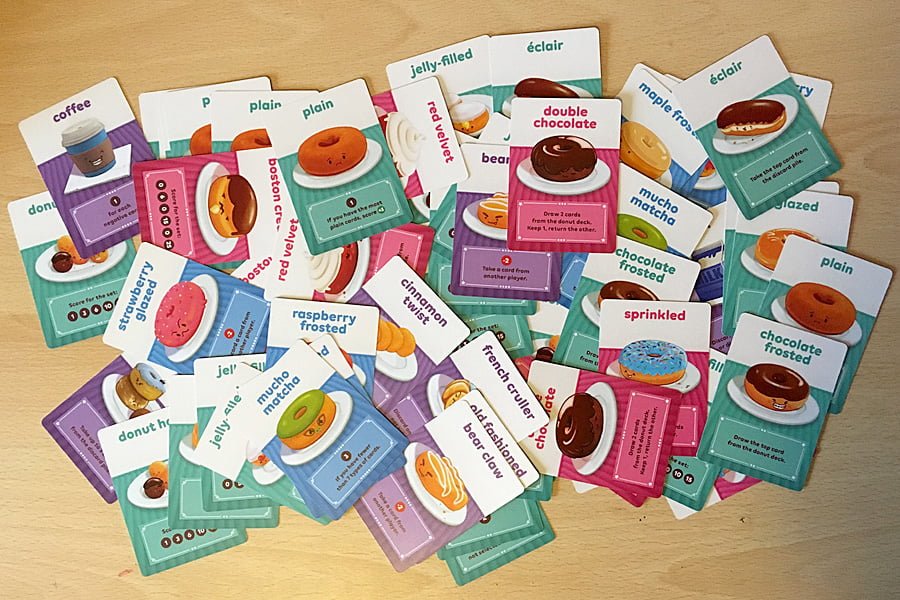
The artwork is really appealing as well, with the cute cartoon donuts reminding me strongly of games like Sushi Go and Sundae Split. The age recommendation for Go Nuts for Donuts is eight plus and while the style and theme will certainly appeal to players younger than that, in this case, I would say the advice here is sound. There is a lot of reading required to play Go Nuts for Donuts thanks to the variety of card types, and a lot of thinking needed to figure out how best to use those cards to your advantage while also attempting to out-think other players (remember that if two or more players select the same card, no one gets it). While some younger kids will probably be able to play, many will quickly find the game frustrating when they need an adult to help them understand what every card does.
Of all the games I picked up at this year’s Toy Fair, Go Nuts for Donuts has easily been the most popular with my family and I can’t help but think it will go down a treat with yours as well.
GeekMom received a copy of Go Nuts for Donuts for review purposes.

